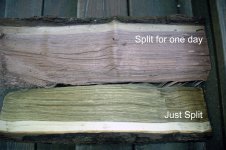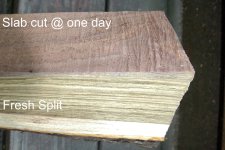forgeblast
Elite Member
Great write up love the pics.
You sawdust is way too "fine", you should be throwing much larger chips which is slowing you down some...although on the plus side it produces a smoother cut. What degree are you filing and how often are you sharpening?? Most go between zero and 10 degrees, re-sharpen after a few slabs. I need to find my Woodbug video on rip chain sharpening for you. He does things a little different(25 degree top angle and 15 degree down angle) and files into the cutter...not away like most of us were taught. The hard chrome coating on the cutting tooth is what does the cutting. Filing away makes little jagged edges of the coating hang off the cutter which soon get broken off leaving a tiny divit on the cutting edge(dull). Filing into the cutter smooths that hard chrome and blends it into the steel of the tooth so there is nothing to break off and the edge stays sharper longer. Filing both ways the chain is equally sharp to begin with, but I found that filing "in" made the my chains go much longer between sharpening's. Give it a try...I only file "in" now on all my saws, besides how did Dad teach us to sharpen a knife....."in" right?
Another East TN chainsaw mill operator here, I've got a Logosol mill. As for sharpening, I keep several low profile ripping chains, I have a dedicated sharpening station I made out of an 8x8 cant on a couple of saw horses with a chainsaw bar vise on top. I use two Pferd chainsaw files, one set for left teeth and one for right teeth. With a good setup and a little practice the sharpening is fast and easy.


I went to a place to get some blue plastic drums and lids. The guy was talking to another person and told us to walk around and see what he had for sale. He had some black wanuts in the hull. I picked one up and tossed it to my buddy. He didnt know what it was and tried opening it up. His hands were stained, and the guy selling the drums just laughed and told him what it was.
I have some black walnut planted in my crep land, its not ready to give off any nuts yet. Does butternut stain also?